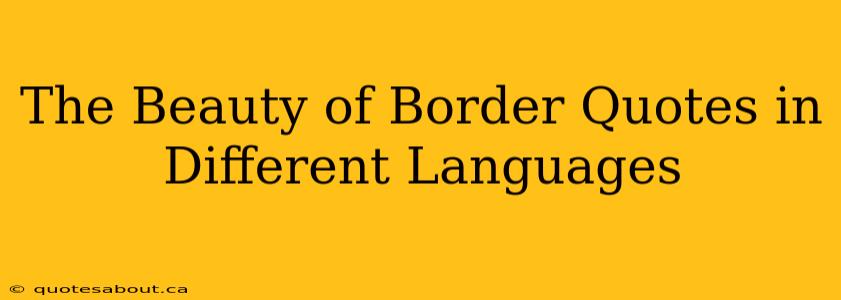Border quotes, those elegant snippets of text that grace the edges of images, pages, or designs, possess a unique charm. They add a touch of sophistication, personality, and often, a deeper meaning to any visual presentation. While often overlooked, the power of a well-chosen border quote, especially when expressed in a different language, can significantly elevate the aesthetic and intellectual appeal of your work. This exploration delves into the beauty of border quotes, particularly focusing on the impact of multilingualism.
Why Use Border Quotes?
Border quotes serve several crucial purposes:
- Setting the Tone: They immediately establish the mood and overall feeling of the piece. A playful quote creates a lighthearted atmosphere, while a profound quote fosters reflection.
- Adding Context: They can provide additional context or insight into the central image or theme, enriching the viewer's understanding.
- Enhancing Aesthetics: Visually, they frame and complement the main content, adding a touch of elegance and sophistication.
- Creating a Unique Identity: A well-chosen quote can make your work stand out, reflecting your personal style or the message you wish to convey.
The Impact of Multilingual Border Quotes
Using a border quote in a language other than the dominant language of your audience can significantly amplify its impact:
- Intrigue and Curiosity: An unfamiliar language instantly sparks curiosity, inviting the viewer to decipher its meaning. This interaction fosters a deeper engagement with your work.
- Cultural Nuance: The choice of language itself conveys cultural significance, enriching the overall message and adding layers of meaning. A quote in French might evoke feelings of romance, while one in Japanese could suggest serenity or wisdom.
- Aesthetic Appeal: Different languages possess unique typographic characteristics. The visual impact of the script itself can enhance the overall aesthetic appeal of your border design.
- Expanding Reach: By incorporating quotes in multiple languages, you can broaden your work's appeal to a wider, more international audience.
What are some popular languages to use for border quotes?
The ideal language for your border quote will depend heavily on the context and the overall message you wish to convey. However, some languages are frequently chosen for their aesthetic appeal and cultural connotations:
- French: Often associated with romance, elegance, and sophistication.
- Italian: Known for its passion, beauty, and artistic heritage.
- Spanish: Conveys warmth, vibrancy, and a passionate spirit.
- Latin: Imparts a sense of history, wisdom, and classical learning.
- Japanese: Suggests serenity, minimalism, and a connection to nature.
- Arabic: Evokes a sense of mystery, tradition, and rich cultural heritage.
How to Choose the Right Border Quote in a Different Language?
Selecting the perfect border quote requires careful consideration:
- Relevance: The quote must align perfectly with the theme and overall message of your work.
- Translation Accuracy: Ensure accurate translation to avoid misinterpretations or unintended meanings.
- Aesthetic Harmony: The font and script should complement the overall visual design.
- Cultural Sensitivity: Be mindful of cultural nuances and avoid potentially offensive or inappropriate phrases.
Where can I find translated quotes for border use?
Numerous online resources offer translated quotes, although always verify the accuracy of the translation before using it. Many translation websites and quote databases can be helpful resources. Remember to cite the original source of the quote when appropriate.
What are some tips for designing border quotes effectively?
- Font Selection: Choose a font that is legible and complements the overall design aesthetic.
- Placement: Strategically place the quote to create visual balance and harmony.
- Color Coordination: Select colors that contrast or complement the background and main image.
- Size and Spacing: Ensure the quote is neither too large nor too small, with appropriate spacing for readability.
By carefully considering the language, context, and design elements, you can harness the power of multilingual border quotes to create truly captivating and memorable pieces. The beauty lies not only in the words themselves but also in the cross-cultural communication and artistic expression they facilitate.

